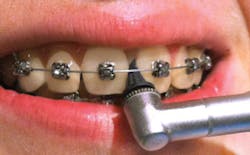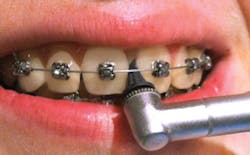Bless its pointed little head
Pointed polishers are quite the helpful little friend
BY DIANE RAPH-PINESCHI, RDH
After reading this article, I bet you will sit back and think, "How did I manage without these little guys." I am referring to the triangular, pointed rubber polishing adjuncts, also known as "pointed polishers."
I always thought they were cute. When I graduated from Northwestern University in 1980, I had no idea how they were supposed to be used. Over the years, I would get a few inklings from fellow hygienists or dentists. After all these years, here's an accumulation of the many uses for these handy little things.
Pointed polishers come in several forms. They are usually made of natural rubber (that means they are latex-free). It is generally best to stay latex-free in a dental office. All it takes is that one person with a true latex allergy to put a damper on your day.
Single pointed polishers screw onto a prophy angle. Additionally, a latch-type version is for colleagues who use the latch-type angle. One innovative company has put together a prophy cup with a pointed polisher in it. When you have finished polishing, you can snap off the cup and have the pointed polisher ready to use. Another innovative company now has the pointed polishers attached to disposable angles. In some cases after polishing, it may be necessary to switch from a disposable angle to a metal prophy angle to attach the little pointed device.
Some dental supply companies say the points are autoclavable. However, I find that they tend to deteriorate and become stiff and brittle if you autoclave them several times. The rubber gets quite dried out, and you don't want to risk having pieces of it fly around the mouth like a blown-out tire on the freeway. It can be a mess, and aspiration can cause a real problem if this occurs. I just toss mine after one use. Also, I find they tend to rot and disintegrate if you store them an excessively long time. I know this because I found an unopened bag tucked away in the back of a drawer under the drawer liner, probably hidden during the rationing of rubber back in 1942.
The most common use of the pointed polishers is for interproximal areas. They help to get into deep areas between the teeth to remove plaque. If you use them in conjunction with polish, they also can help remove stubborn interproximal stains. If someone has a diastema or large spacing between the teeth, polishing with the pointed polisher is a great way to clean the sides of the teeth and help minimize the scraping needed to remove stain.
Another common usage is with orthodontic wires. Personally, after I polish a person with orthodontic brackets, I switch to my little pointed friend and then repolish, taking care to go between the wires, coming down like a stalactite from the incisal aspect of the tooth into the space between the wire and the tooth, and then coming up like a stalagmite to clean the space from the gingival areas between the tooth and the wire. They are pretty flexible and the ribbing on the surface is great for this usage. Do not forget to have enough prophy polish as these areas always attract heavy stain. The same concerns hold true when cleaning lingual splints or permanent retainers. Along with floss threaders, these little guys work very nicely to get into all the difficult nooks and crannies.
Now for some fun things to do with our little friend:
- Implants — The rubber points have no exposed metal to scratch the titanium, and the little grooves of the pointed polisher get into areas that are hard to reach. The point or tip can even be used to clean into the interproximal space around an implant. I suggest you do this with no prophy paste, as you don't want anything to be introduced into deeper sulcus areas and create a problem. It is always better to be safe than sorry.
Also, when you have two or more implants splinted to each other and the restoration is screw-retained with the abutment screw exposed, bring on the pointed polisher for this area as well. It does a great job cleaning here. Along the same line, the healing caps/abutments have little screw "holes" in the center of their occlusal aspect. The rubber tip is great to get the plaque, food, or even leftover polish out, making them beautifully shiny and clean.
- Furcations — Have you tried to get all the food debris and plaque out of the larger furcations. Hard, isn't it? I use the air syringe, and it still isn't perfect. Once again, it's time for the little rubber polisher. Here again, I would hesitate to use polish on it; you do not know what is lurking in a furca that you might awaken. If you do use polish, be sure to thoroughly irrigate the area following polishing. Even a smaller furca can be cleaned with the little tip. The larger ones usually envelope the whole triangle of rubber, but it always seems to do a great job.
- Bridges — If a three or more unit bridge has a high pontic, and you can get under the bridge with a pointed polisher, go for it. It will thoroughly clean the underside of the pontic. Of course, floss works great here as well, but the rotating action of the ribbed point will repeatedly strike the pontic area, thereby cleaning it quite thoroughly. As an added bonus, you can place topical fluoride on the point to introduce more fluoride in to the area where the pontic and the crown meet, which is a popular place for decay to begin.
- Pits with incipient decay — Some people present with what I call "decay holes." You know, where there is a ton of plague and food buildup, and your scaler can get most of it and then you try to get more out with the gauze or a cotton swab. The little rubber point is wonderful to use in this case. I had a patient with decay all over, and he had one "decay pit" that was huge. The tooth was probably going to be extracted but it is best to remove any bacteria before an extraction to help promote proper healing. Even if it was not slated for the hazardous material bucket, I wanted the patient's mouth as clean as humanly possible. So, out came my pointed friend. It worked great. You could use it with polish, unless the patient is hypersensitive. I think the polish is good to use in this case, as it is slightly abrasive and the bit of fluoride in it can't hurt in a "decay pit."
- Incisal ditches — We know the ditches and grooves on the incisal areas love to collect stain and calculus, as well as being covered in plaque. A lot of polish (maybe if you have leftover plain pumice from the 1970s) and the pointed polisher can help to an extent here as well. It probably won't be miraculous, but it can help.
Lastly, for teeth that are overlapped, the points can be used to get into the crevices that can stain up or collect buildup. The sides of the polisher have ribs which can help clean the overlapping teeth.
Hope you see my little pointed friend in a new light after reading this. I know they are a very important part of my prophy routine; hopefully, they will become part of yours as well. RDH
Diane Raph-Pineschi, RDH, is a very happily employed dental hygienist who graduated from Northwestern University in 1980. She has been in practice full time for 33 years, 29 years in a Los Angeles periodontal practice. She can be contacted at [email protected].
Past RDH Issues

